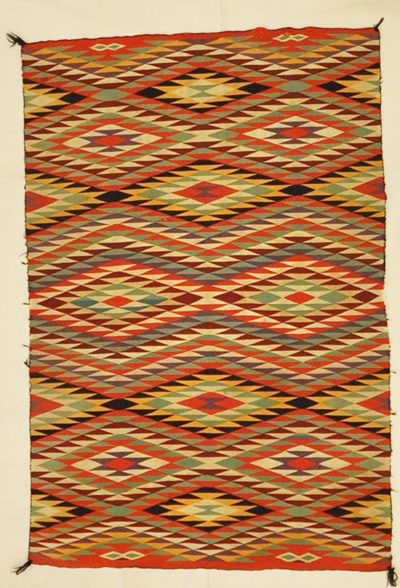

The Navajo (Native American Indian Tribe) reside in the Southwestern United States in the 4 Corners region encompassing large areas of present-day Arizona, Utah and New Mexico. Transitional weavings, circa 1885 to 1910, represent an under appreciated class of Navajo textiles often overlooked as being made during a less important time of Navajo weaving. Trading posts started to pay weavers by the weight of the weaving instead of the quality or design of the textile. Many weavings produced during this time frame were loosely woven to increase weight and hence value. These heavier blankets were called “pound blankets.” The traders figured out very quickly that paying for weavings in this manner decreased blanket quality eventually causing them to abandon this practice. Until recently, what has not been recognized is the incredible artistic exploration that occurred during this time forced by economic pressures on Navajo weavers to stop making blankets for wear and shift to producing floor rugs. Before the turn of the century, the Navajo switched from making traditional Native American blankets to weaving thick, brilliantly colored rugs with hand-spun wool. The development of eye dazzler designs woven with commercial yarn, known as Germantown blankets, were named for the Pennsylvanian mills that manufactured the four-ply yarn. These tightly woven weavings, which often used cotton warp, did not hold up well on the floor and soon lost favor as floor rugs.
Though not always considered the epicenter of the Navajo culture, Eye Dazzlers offer weavers the chance to express their individual artistry, freedom and ceremonial musings. With little or no guidelines as to what constitutes a rug, other than a border around the edge, creativity gave way to unique designs that appealed to the weaver’s sense of what was beautiful. Thus inspire those who purchase them to be influenced by the weavers infusion of spirit into their designs, creating a common bond with the artist and collector. This dramatic shift featured “eye dazzling” geometric shapes and color palettes never before seen in such a medium, giving birth to what is now known as the Eye Dazzler rug. Elaborate weavings boasting gorgeous jelly bean colors, Eye Dazzlers became one of the very first Navajo weaving styles beyond blankets and serapes. These weavings used simple stripes, rectangles, squares, triangles and chevrons for their main focal designs. While the weavings were exquisitely woven and designed, the motifs were often similar in composition. This rare textile is woven of native hand-spun wool with natural indigo and aniline dye with the finest yarn, which has been pressed hard to create this fine work of art. Between the change in hues and tones, geometric patterns, and even wool’s available for weaving, this groundbreaking rug style set the stage for weavings, tapestries and Navajo weaving expansion for more than a century. Transitional blankets are undervalued for what they truly represent; wearing blankets made by a culture prized for their weaving abilities, which this current example clearly sets itself apart from the ordinary into the realm of world class woven art.
Navajo rugs and blankets of the Germantown style originate from a period in the 1860’s, when over 8,000 Navajo Indians were forcibly located to an area in New Mexico called Bosque Redondo. As the Santa Fe railroad brought settlers to the West, and trading posts carried synthetic dyes and commercial yarns in beautiful colors from Germantown Pennsylvania, eventually settling down in an internment site of eastern New Mexico . It was at this internment site that the Navajo weavers began using manufactured yarns dyed with brighter ranges of colors than were available through natural wool dying methods. The use of these dyes provided Navajo weavers with the opportunity to experiment with new designs and styles, including the famous “eyedazzler” blankets, easily recognizable by the trademark diamond and cross patterns.
This historic piece of woven art is currently on public view at Santa Barbara Design Center.
410 Olive Street. Santa Barbara, Ca. 93101
